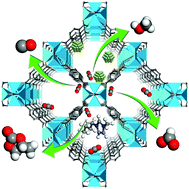Carbon capture and conversion using metal–organic frameworks and MOF-based materials
Abstract
Rapidly increasing atmospheric CO2 concentrations threaten human society, the natural environment, and the synergy between the two. In order to ameliorate the CO2 problem, carbon capture and conversion techniques have been proposed. Metal–organic framework (MOF)-based materials, a relatively new class of porous materials with unique structural features, high surface areas, chemical tunability and stability, have been extensively studied with respect to their applicability to such techniques. Recently, it has become apparent that the CO2 capture capabilities of MOF-based materials significantly boost their potential toward CO2 conversion. Furthermore, MOF-based materials’ well-defined structures greatly facilitate the understanding of structure–property relationships and their roles in CO2 capture and conversion. In this review, we provide a comprehensive account of significant progress in the design and synthesis of MOF-based materials, including MOFs, MOF composites and MOF derivatives, and their application to carbon capture and conversion. Special emphases on the relationships between CO2 capture capacities of MOF-based materials and their catalytic CO2 conversion performances are discussed.

- This article is part of the themed collection: Celebrating our 2020 Prize and Award winners


 Please wait while we load your content...
Please wait while we load your content...